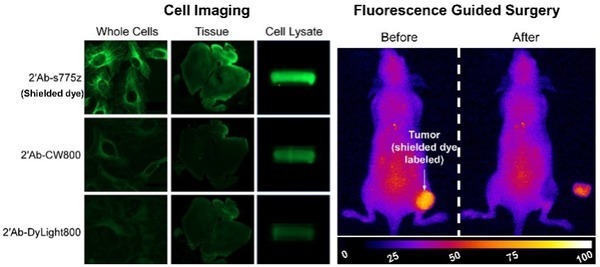High Performance Fluorescent Near-Infrared Dyes
Tech ID: 20-015
Inventors: Dr. Bradley Smith, Donghao Li
Date Added: June 4, 2021
Overview
A new fluorescent dye compound with high performance properties for fluorescent guided surgery.
Technology Summary

Organic fluorescent dyes are of great interest in many medical applications such as fluorescent guided surgeries, imaging, rapid pathology, and biomedical diagnostics. The ability to resect tumors currently relies on visual localization and many small tumors are more easily observed if they are labeled with a molecular probe that contains a fluorescent dye. Dyes that fluoresce in the near-infrared range of 700-900 nm are of particular interest because these wavelengths allow medical professionals and researchers to see deeper into tissue. At present, the only FDA approved near-infrared dye is ICG which cannot be appended to cancer targeting molecules such as peptides or antibodies and so has limited utility for tumor imaging. IR Dye 800CW® is an alternative commercial dye that can be converted into targeted imaging probe molecules, but the targeting specificity is diminished by the dye’s high negative charge. In addition, there is significant dye aggregation during antibody conjugation, resulting in a significant loss of fluorescent brightness, low solubility, and poor pharmacokinetics.
Researchers at the University of Notre Dame have recently developed a new fluorescent dye that emits at ~800 nm and exhibits unsurpassed fluorescence imaging performance. The chemical structure of this novel dye has shielding arms that block dye aggregation and enhance the fluorescence brightness, allowing researchers to see deeper into tissue or allowing for a smaller dose. The ND shielded dye has better near-infrared fluorescence and pharmacokinetic properties than currently available dyes. It is easily appended by standard bioconjugation chemistry to peptides or antibodies to produce targeted imaging probe molecules for diagnostics or imaging. Clinically, it permits accurate surgical navigation, reduced time required for cancer surgery, and rapid pathology.
Market Advantages
- Greatly Increased Fluorescence Brightness and Photostability – Easy bioconjugation chemistry
- Reduced Surgery Time – Less stress on patients
- Reduced Risk, Better Prognosis & Remission Rates – A brighter dye would reduce the risk of a surgical oncologist missing any cancer cells
Market Applications
- Reagent for Diagnostics and Preclinical Imaging Research – $17.37B
- Fluorescent Guided Surgery – $2.5B, 14.6% CAGR
Technology Readiness Level
TRL 4 - Lab Validation
Publications
“Sterically Shielded Heptamethine Cyanine Dyes for Bioconjugation and High Performance Near-Infrared Fluorescence Imaging" 2020 Angewandte Chem. Int Ed., 59, pp. 12154. DOI:10.1002/anie.202004449.
“High-Performance Near-Infrared Fluorescent Secondary Antibodies for Immunofluorescence” 2021 Anal. Chem., 93, pp. 3643. DOI: 10.1021/acs.analchem.1c00276
Intellectual Property Status
PCT/US2021/018994